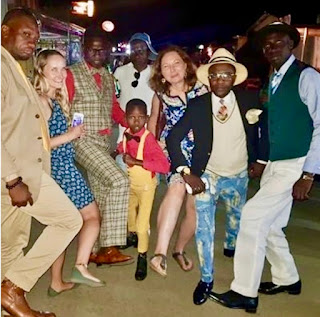Les Sapeurs du Congo
 |
| Hanging out after the street show |
The name of the movement comes from the phrase Société des Ambianceurs et des Personnes Élégantes (SAPE). In Congo, it doesn't matter who you are and where you work - anyone can be le Sapeur, men and women (les Sapeuses). The movement is supposed to embody the elegance in style. Some say le SAPE began with soldiers coming home from the First World War who brought the latest Parisian fashions with them. They took to dressing up and showing off and it made them feel rich and important.
At the beginning les Sapeurs were not very popular, sometimes even banned from public spaces. Now, they have status as a part of Congo’s cultural heritage and became a symbol of the country. They participate in public cultural events or just stroll down the streets, showing off their elaborate outfits. Some are beginning to create their own original designs, as they believe it is not about the price but rather about the style - how you combine colors is more important than how much you paid for your clothes. However, for the traditionalists it is still the price that signifies the true way of les Sapeurs.
There are regular contests around town involving les Sapeurs - they present several outfits in one evening and at the end, there is a prize. But truly, none of this is done for money. Les Sapeurs sacrifice their lives for fashion for no evident gains other than the opportunity to feel rich and fancy.
The first time I encountered les Saperus was in October 2019 at Chez de Guy which is a sidewalk bar not far from Les Rapides, during one of such contests. I was with a group of Polish tourists and when we arrived only three of the les Sapeurs were present. We sat down, ordered drinks and took in the local flavor. Within the next hour or so, the group of Sapeurs grew to seven, including a young boy. They practiced their fancy walks, they fanned their jackets and took off their hats.
The boy was carrying a black, lacy umbrella. Colorful shoes shone in the evening light. After the initial practice, they strolled as a group, followed by individual walks. Each Sapeur has a different style. Their movements are hard to describe – it was not a dance but rather a series of angular movements with elements of tap dance. Apparently, there were judges involved and the winner was getting a small prize. We never found out what the prize was or who won. I suspect that the biggest price of the evening was the fee we, the tourists, were charged for the pleasure of seeing them.
 |
| Les Sapeurs at the AISB |
My second encounter with les Sapeurs happened at the American International School of Brazzaville. They were invited to do a show during the Spring Bazaar and, as a teacher, I got to be one of the judges! This time there were both men and women. They all changed their outfits twice and described in great detail on stage exactly what they were wearing.
I have great appreciation for how elegant Congolese are, how beautifully they dress to celebrate various occasions. There is pride and beauty in that. I feel the traditional Sapeurs are missing a tremendous opportunity… What if instead of spending thousands of francs on overpriced western designer clothes they promoted equally talented and creative African designers? It would still be fancy and frankly, I think it would have the potential of attracting even more tourists. That I would understand, support and come see regularly!




Comments
Post a Comment